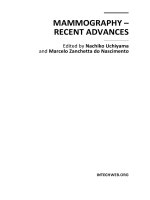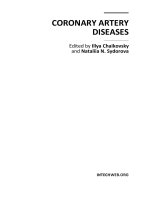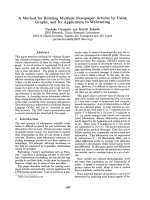Bone Grafting Edited by Alessandro Zorzi and João Batista de Miranda ppt
Bạn đang xem bản rút gọn của tài liệu. Xem và tải ngay bản đầy đủ của tài liệu tại đây (22.85 MB, 214 trang )
BONE GRAFTING
Edited by Alessandro Zorzi
and João Batista de Miranda
Bone Grafting
Edited by Alessandro Zorzi and João Batista de Miranda
Published by InTech
Janeza Trdine 9, 51000 Rijeka, Croatia
Copyright © 2012 InTech
All chapters are Open Access distributed under the Creative Commons Attribution 3.0
license, which allows users to download, copy and build upon published articles even for
commercial purposes, as long as the author and publisher are properly credited, which
ensures maximum dissemination and a wider impact of our publications. After this work
has been published by InTech, authors have the right to republish it, in whole or part, in
any publication of which they are the author, and to make other personal use of the
work. Any republication, referencing or personal use of the work must explicitly identify
the original source.
As for readers, this license allows users to download, copy and build upon published
chapters even for commercial purposes, as long as the author and publisher are properly
credited, which ensures maximum dissemination and a wider impact of our publications.
Notice
Statements and opinions expressed in the chapters are these of the individual contributors
and not necessarily those of the editors or publisher. No responsibility is accepted for the
accuracy of information contained in the published chapters. The publisher assumes no
responsibility for any damage or injury to persons or property arising out of the use of any
materials, instructions, methods or ideas contained in the book.
Publishing Process Manager Jana Sertic
Technical Editor Teodora Smiljanic
Cover Designer InTech Design Team
First published March, 2012
Printed in Croatia
A free online edition of this book is available at www.intechopen.com
Additional hard copies can be obtained from
Bone Grafting, Edited by Alessandro Zorzi and João Batista de Miranda
p. cm.
ISBN 978-953-51-0324-0
Contents
Preface IX
Part 1 Introduction 1
Chapter 1 Introduction 3
Alessandro Rozim Zorzi
and João Batista de Miranda
Chapter 2 Basic Knowledge of Bone Grafting 11
Nguyen Ngoc Hung
Part 2 Basic Science 39
Chapter 3 Influence of Freeze-Drying and Irradiation
on Mechanical Properties of Human Cancellous
Bone: Application to Impaction Bone Grafting 41
Olivier Cornu
Part 3 Trauma Surgery 59
Chapter 4 Bone Grafting in Malunited Fractures 61
Fernando Baldy dos Reis
and Jean Klay Santos Machado
Chapter 5 Reconstruction of Post-Traumatic Bone Defect
of the Upper-Limb with Vascularized Fibular Graft 75
R. Adani, L. Tarallo and R. Mugnai
Part 4 Orthopaedic Surgery 89
Chapter 6 Congenital Pseudarthrosis of the Tibia: Combined
Pharmacologic and Surgical Treatment Using
Biphosphonate Intravenous Infusion and Bone
Morphogenic Protein with Periosteal and Cancellous
Autogenous Bone Grafting, Tibio-Fibular Cross Union,
Intramedullary Rodding and External Fixation 91
Dror Paley
VI Contents
Chapter 7 Osteonecrosis Femoral Head Treatment
by Core Decompression and ILIAC
CREST-TFL Muscle Pedicle Grafting 107
Sudhir Babhulkar
Chapter 8 Treatment of Distal Radius Bone
Defects with Injectable Calcium Sulphate Cement 125
Deng Lei, Ma Zhanzhong, Yang Huaikuo,
Xue Lei and Yang Gongbo
Chapter 9 Spinal Fusion with Methylmethacrylate Cage 135
Majid Reza Farrokhi and Golnaz Yadollahi Khales
Chapter 10 Treatment of Chronic Osteomyelitis Using
Vancomycin-Impregnated Calcium Sulphate Cement 147
Deng Lei, Ma Zhanzhong, Yang Huaikuo,
Xue Lei, Yang Gongbo
Part 5 Oral and Maxillofacial Surgery 157
Chapter 11 To Graft or Not to Graft? Evidence-Based
Guide to Decision Making in Oral Bone Graft Surgery 159
Bernhard Pommer, Werner Zechner,
Georg Watzek and Richard Palmer
Chapter 12 Clinical Concepts in Oral and Maxillofacial Surgery
and Novel Findings to the Field of Bone Regeneration 183
Annika Rosén and Rachael Sugars
Preface
It was a great pleasure to receive the invitation to coordinate the edition of a book
devoted to bone grafting surgery from InTech. Bone is the second most frequently
transplanted tissue in the human body, after blood. Nearly one million bone graft
procedures are performed worldwide each year. Although autologous bone graft
remains the gold standard procedure, the pursuit of substitutes, to avoid clinical
morbidity, is one of the greatest fields of research nowadays. The initial proposal
offered to us, presented the project of an open access book, directed to a broad
audience, formed by researchers, students and clinical practitioners.
This project caught our attention because of two important reasons. First, because the
breadth of the subject, constituted by bone grafts and bone grafts substitutes, causes it
to be partially addressed in isolated chapters inserted in textbooks of different fields,
such as orthopedics, neurosurgery, plastic surgery and dentistry. There are only few
textbooks focusing specifically the theme, frequently printed editions which are often
difficult to acquire. This is the second reason that makes this project so interesting.
Also, as an open access online book, it is available everywhere around the world.
In addition to allow worldwide reading, this book also has the advantage to put
together authors from different continents, with different point of views and different
experiences with bone grafting. Leading researchers of Asia, America and European
countries contributed as authors. In this book, reader can find chapters from basic
principles intended to students, to research results and description of new techniques
from which experts can benefit a great deal.
We wish to thank the authors, which contributed with their time and wisdom, to make
this project possible. We wish to thank specially the InTech Publishing Process
Managers, Jana Sertic and Ivana Zec, for their help and support.
Alessandro Rozim Zorzi, MD, MSc
Orthopedics and Traumatology Department, Campinas State University (UNICAMP),
Brazil
João Batista de Miranda, MD, PhD
Orthopedics and Traumatology Department, Campinas State University (UNICAMP),
Brazil
Part 1
Introduction
1
Introduction
Alessandro Rozim Zorzi and João Batista de Miranda
Campinas State University - UNICAMP,
Brazil
Bone grafting represents an exciting field of study and a major advance of modern surgery.
It is an important tool that allows surgeons to deal with different and difficult situations.
Massive tissue loss or impaired bone healing, caused by tumors, trauma, infections or
congenital abnormalities, were unsolved problems until the recent development of bone
grafting one century ago. Bone graft could be defined as a bone fragment transplanted,
whole or in pieces, from one site to another. Bone grafting is the name of the surgical
procedure, by which bone graft, or a bone graft substitute, is placed into fractures or bone
defects, to aid in healing or to improve strength.
Bone is the second most commonly implanted material in the human body, after blood
transfusion, with an estimated 600.000 grafts performed annually only in the USA 1.
Besides its frequent use, bone grafting study is also important because it is used by many
specialties of Medicine and Dentistry, like Orthopedics, Traumatology, Neurosurgery,
Spinal Surgery, Plastic Surgery, Hand Surgery, Head and Neck Surgery, Otolaryngology,
Maxillofacial Surgery and others.
The correct and effective use of bone graft takes not only precise surgical technique skills, to
harvest it and to deliver it to host bed, but also a deep theoretical knowledge, to understand
its mechanical and biological behavior during graft integration to host tissues.
So, it is important to all surgeons and specialists involved somehow with bone grafting
procedures, to have knowledge of some basic principles that will be presented along this
and the following chapters. To understand the actual state of the art, it is important to begin
by knowing the pioneers that initiate the history of bone grafting.
1.1 History
In the 19th century, three important scientific discoveries stimulated the rapid development
of Modern Surgery: the advent of Anesthesia, attributed to William Thomas Green Morton
in 1846; the use of asepsis and the development of an antiseptic solution to prevent infection
in surgery, by Joseph Lister; the discovery of X-Ray by Wilhelm Conrad Röentegen, which
performed the first radiography, taken by the hand of his wife in December 1895. These
iscoveries boosted the surgical treatment of fractures during First World War
2
.
Parallel to the rapid development of metallurgy, which allowed the rigid fixation of bone
fractures with increasingly expensive implants, there was a slowly, but important,
understanding of the biology of bone healing.
Bone Grafting
4
Although reports of autologous bone grafting date back to the ancient Egypt, the first
description of systematic use of autologous bone grafting, with the modern principles and
concepts, is attributed to Fred H. Albee (1876 – 1945), a North American surgeon that
served during the First World War, and published in 1915 a textbook named “Bone Graft
Surgery”. Before Albee, occasional reports described the use of various forms of bone
grafts.
In the 17th century, there was an isolated report of a successful bone xenograft, performed
by Job van Meekeren, who treated a bone defect in the skull of a Russian soldier with a
dog’s skull bone. It takes two centuries to appear a new reference about this kind of surgery.
In 1881, MacEwen was able to reconstruct the umerus of a child with a cadaveric bone. Barth
and Marchand also observed that the bone from autograft, when transplanted to another
site, goes to necrosis and are subsequently invaded by host cells that differentiate to bone
cells and produce new bone. In that way, those authors demonstrated that a fragment of
bone take from one site can substitute bone from another site.
The French surgeon Léopold Ollier (1830-1900), called “The Father of Bone and Joint
Surgery” and “The Father of Experimental Surgery”, shed a significant light on the function
of the periosteum, reflected in his “Traité de Régénération Osseuse Chez L'Animal”. He also
performed autologous and homologous bone grafting in humans.
Georg Axhausen (1877-1960) and Erich Lexer (1867-1937), German surgeons, and the North
American surgeon Dallas B. Phemister (1882-1951), played an important role to make bone
grafting recognized as rational and viable. Axhausen and Phemister described the graft
incorporation process by the host organism. Lexer published clinical cases of bone
allografting with twenty years follow-up, with good results in half of patients
3
.
In the 40
th
decade, Wilson (1947) and Bush (1948) described freezing storage techniques for
preserving allografts, giving rise to the era of tissue banking
4,5
. After the end of the Second
World War, tissue banks become more complex, with the need to create protocols and rules
to control the use and safety of musculoskeletal tissues. The American Association of Tissue
Banks (AATB) was founded in 1976 by a group of doctors who had started in 1949 the first
full tissue bank of the world, the United States Navy Tissue Bank
6
.
Following the creation of AATB, the Asian Pacific Association of Surgical Tissue Banking
was done. In a few years after 1949, additional regional tissue banks were established in
Europe as well. Those first European regional and national tissue banks were established in
the former Czechoslovakia in 1952, the former German Democratic Republic in 1956, in
Great Britain 1955 and in Poland in 1962. Only after the end of the “Cold War” and the
reunification of Berlin, it was born the European Association of Tissue Banks (EATB), in
1991
7
.
In the 60’s decade, Marshall R Urist (1914-2001) established the osteoinductive capacity of
Demineralized Bone Matrix (DBM), which leads to the discovering and understanding of
a family of proteins called Bone Morphogenetic Proteins (BMPs)
8,9,10,11,12
. Both DBM and
BMP are available nowadays to clinical use isolated or in combination with scaffolds. This
finding started a new era in bone grafting, leading to the development of graft substitute
research.
Introduction
5
1.2 General indications for bone grafting
In brief, the major indications to the use of some kind of bone grafting procedure are the
following
13
:
Reconstruction of skeletal defects of multiple etiologies, like tumors, trauma,
osteotomies and infections.
Augmenting fracture healing, in the treatment of delayed-union and non-union, or in
the prevention of those problems in patients with risk factors (smoking, diabetes).
Fusing joints.
Augmenting joint reconstruction procedures, especially to correct massive bone loss in
revision arthroplasties.
1.3 Types of bone grafts
Bone grafts could be classified in different manners, according to its sources (table 1),
surgical location (table 2) or time to use (table 3)
14,15
.
Autograft A graft moved from one site to another within the same individual.
Allograft
Tissue transferred between two geneticall
y
different individuals of the
same species.
Xenograft
Tissue from one species into a member of a different species.
Isograft
Tissue from one twin implanted in an identical (monozygotic) twin.
Table 1. Type of bone graft according to its source.
Orthotopic Anatomically appropriate site. Ex: delayed union of a bone
fracture.
Heterotopic
Anatomically inappropriate site. Ex: subcutaneous tissue.
Table 2. Type of bone graft according to its surgical location.
Fresh Transferred directly from the donor to the recipient site, in the case
of autografts, or held for a relatively short time, in culture or storage
medium, in the case of allografts (fresh-frozen).
Preserved
Maintained stored for a relatively long time in a tissue bank, by
freezing, freeze-drying, irradiation or chemical treatment.
Table 3. Type of bone graft according to its time until implantation.
Bone grafts could also be classified as cortical, cancellous or corticocancellous, according to
the type of bone present in the graft. Cortical bone grafts are used for structural support.
Cancellous bone grafts are used for osteogenesis. These properties could be combined in a
corticocancellous graft.
Although the name, vascularized bone grafts will not be approached in this chapter, because
it is better understand in the field of microsurgical flaps.
Bone Grafting
6
1.4 Properties
Bone grafts present mechanical and biological properties. The biological properties are
divided in Osteoconduction, Osteoinduction and Osteogenesis.
Osteoconduction is defined as the propertie of bone graft to serve as a framework to cells of
the host (mature osteoblasts) that uses it as a porous three-dimensional scaffold to support
in-growth. It depends of the host surrounding viable tissue to survive and incorporates. This
effect could be exerted by autograft, allograft and bone graft substitutes. Autograft is always
the gold-standard procedure; to wich the other must be compared. However, autograft
harvest presents a series of complications, like pain, bloody loss, long surgical time, risk of
nerve or vascular injurie, and scars. So the use of alternatives is very attractive, principally
when the graft indication is for osteoconduction. Several artificial substitutes have been
developed
16,17,18,19
.
They could be divided in biological or non-biological materials.
Biological:
Porous coralline ceramics
Calcium sulfate
Calcium phosphate
Type 1 collagen (Col1);
Numerous commercially available combinations of the above materials.
Non-biological:
Degradable polymers (polylactic acid and polyglycolic acid);
Bioactive glasses;
Ceramics;
Metals.
Osteoinduction is defined as the enhancement of bone formation, by the stimulation of host
osteoprogenitor cells to differentiate to osteoblasts. It is used to enhance bone healing, to
treat bone loss from trauma, tumor, osteonecrosis or congenital conditions. The gold-
standard procedure is the autograft, but the pursuits of substitutes to avoid harvest
complications lead to a significant improve in the understanding of growth factors that
mediates bone formation. The most studied is a family of proteins called BMPs (Bone
Morphogenetic Proteins).
Osteogenesis is defined as bone formation, from cells that survive in the graft and are
capable of produce new bone. When new bone is formed from host cells which penetrate
graft from surrounding tissue, this is called osteoinduction. It is indicated when the host
conditions are impaired, like in fracture non-unions. Gold-standard procedure is autograft,
but beyond the inconvenience of harvest, the limited quantity available is a major concern.
With the development of tissue engineering, the combination of a scaffold with growth
factors and stem cell derived osteo-progenitor cells has becoming a promissory field to
provide large amounts of graft to fill large defects.
Mechanical properties are indicated to support weight-bearing. It could be exerted by
autografts, like fibular non-vascularized transfer to support tibia bone loss (figure 1). With the
Introduction
7
development and expansion of the uses of joint arthroplasties, nowadays it is more common to
use structural allografts in revision arthroplasty surgery to deal with large bone defects.
1.5 Sources of autollogous bone grafts
Surgeons must plan carefully any surgical procedure that involves bone grafting. Small
amounts of cancellous grafts can be obtained from local sites nearby the surgical region:
Greater trochanter of the femur for hip surgery;
Femural condyle for knee surgery;
Proximal tibial metaphysic for knee surgery;
Medial malleolus of the tibia for ankle surgery;
Olecranon for upper extremities;
Distal radius for wrist surgery;
Large cancellous and corticocancellous grafts can be obtained from the anterosuperior iliac
crest and the posterior iliac crest. Cancellous graft can be obtained also from the medular
cavity when reaming procedures are performed.
Fig. 1. An example of a structural autograft: after extensive bone loss caused by a high
energy trauma, non-vascularized fibular diaphises was transferred to the tibia
(“Tibialization of the Fibula”) and fixed with plate and screws (pictures kindly provided by
dr Bruno Livani).
Bone Grafting
8
1.6 Surgical techniques
1.6.1 Anterior iliac bone graft
If the patient is in the supine position for surgery, graft can be obtained from the
anterosuperior iliac spine. This is a very dynamic source, as it provides cortical or cancellous
grafts as well. If the intention is to use osteogenesis alone, bone chips can be removed. If
mechanical support is required, a corticocancellous graft can be obtained with one, two or
three cortical walls (figure 2).
Fig. 2. Autologous bone graft could be obtained from the anterior region of the iliac bone.
An oblique incision (“bikini incision”) over the crest is performed carefully to avoid damage
to the Lateral Thigh Cutaneous Nerve that runs medially to the Antero-Superior Iliac Spine,
superficially to the Inguinal Ligament.
1.6.2 Posterior iliac bone graft
If the patient is prone, the posterior third of iliac bone is used. Caution should be taken to
avoid Cluneal Nerves lesion, restricting the dissection to a line eight cm length from the
posterior superior iliac spine (figure 3).
1.7 Complications of iliac autograft harvesting
Bleeding and haematoma;
Introduction
9
Infection;
Inguinal hernia;
Nerve injury: the lateral femoral cutaneous and ilioinguinal nerves are at risk during
anterior procedure. The superior cluneal nerves are at risk in the posterior procedure
when dissection is extended beyond 8 cm lateral to posterosuperior iliac spine.
Arterial injury: Superior gluteal vessels can be damaged by inadvertent retraction
against the roof of sciatic notch. Arteriovenous fistula and pseudoaneurysm are less
frequent.
Cosmetic deformity;
Pelvic fractures;
Chronic pain;
Insufficient material to fill the defect.
Fig. 3. To take bone from the posterior region of the iliac bone, a longitudinal incision is
done crossing the iliac crest in a point between the Postero-Superior Iliac Spine and a point
eight centimeters lateral to that, over the iliac crest, to avoid damage to the Cluneal nerves
that runs in the subcutaneous tissue.
Nowadays, Autologous Bone Graft is the gold standard procedure. However, to avoid
complications related to it, the pursuit of bone graft substitutes is one of the major fields in
medical research today. The understanding of graft biology (osteogenesis, osteoinduction,
Bone Grafting
10
osteoconduction) and integration to host tissue are paramount to the success of new
materials. In the future, the developing of graft substitutes could be more safety and less
expensive, turning the use of these materials the first choice when dealing with bone loss or
fracture non-unions.
1.8 Acknowledgments
The authors would like to thank Dr. Bruno Livani (pictures) and Ms. Mercedes de Fátima
Santos (illustrations design).
2. References
[1] Marino JT, Ziran BH.”Use of solid and cancellous autologous bone graft for fractures
and nonunions”. Orthop Clin North Am.2010;41:15-26.
[2] The History of Medicine. Woods M, Woods MB. Twenty-First Century Books. 2006.
[3] Miranda JB. Regeneração do tecido ósseo esponjoso, em fêmures de cães, com auto-
enxerto fragmentado e aloenxerto fragmentado e congelado [Thesis]. Campinas
(SP):Universidade Estadual de Campinas;1996. Portuguese.
[4] Wilson PD.”Experiences with a bone bank”. Ann Surg.1947;126(6):932-46.
[5] Bush LF, Garber CZ.”The bone bank”.JAMA.1948;137(7):588-94.
[6] AATB.org [homepage on the internet]. McLean: American Association of Tissue Banks;
c2010 [updated October 2011; cited October 22, 2011]. Available from:
.
[7] EATB.org [homepage on the internet]. Berlin: European Association of Tissue Banks;
c2010 [updated January 2011; cited October 22, 2011]. Available from:
.
[8] Urist MR.”Bone: formation by autoinduction”.Science.1965;150(698):893-9.
[9] Urist MR, Silverman BF, Büring K, Dubuc FL, Rosenberg JM.”The bone induction
principle”. Clin Orthop Relat Res.1967;53:243-83.
[10] Urist MR.”The Classic: bone morphogenetic protein”.Clin Orthop Relat Res.
2009;467(12):3051-62.
[11] Nogami H, Urist MR.”The Classic: a morphogenic matrix for differentiation of cartilage
in tissue culture”. Clin Orthop Relat Res.2009;467(12):3063-7.
[12] Urist MR.”The Classic: a morphogenic matrix for differentiation of bone tissue”. Clin
Orthop Relat Res.2009;467(12):3068-70.
[13] Campbell’s Operative Orthopedics. S. Therry Canale. 10ª Edtion. Mosby 2003.
[14] Stevenson S.”Biology of bone grafts”. Orthop Clin North Am.1999;30(4):543-52.
[15] Stevenson S.”Enhancement of fracture healing with autogenous and allogeneic bone
grafts”. Clin Orthop Relat Res.1998;355S:S239-S246.
[16] Cornell CN.”Osteoconductive materials and their role as substitutes for autogenous
bone grafts”. Orthop Clin North Am.1999;30(4):591-8.
[17] Sanders R.”Bone graft substitutes: separating fact from fiction”. J Bone J Surg
(Am).2007;89A(3):469.
[18] De Long Jr WG, Einhorn TA, Koval K, McKee M, Watson T, et al.”Bone grafts and bone
graft substitutes in orthopaedic trauma surgery”. J Bone J Surg Am.2007;89A(3):649-
58.
[19] Giannoudis PV, Dinopoulos H, Tsiridis E.”Bone substitutes: an update”. Injury.
2005;36S:S20-7.
2
Basic Knowledge of Bone Grafting
Nguyen Ngoc Hung
Hanoi Medial University,
Military Academy of Medicine,
Pediatric Orthopaedic Department - National Hospital of Pediatrics,
Dong Da District, Ha Noi,
Vietnam
1. Introduction
Bone grafting is a surgical procedure that replaces missing bone in order bone fractures that
are extremely complex, pose a significant health risk to the patient, or fail to heal property.
Bone grafting is a very old surgical procedure. The first recorded bone implant was
performed in 1668. Bone grafts are used to treat various disorders, including delayed union
and nonunion of fractures, congenital pseudoarthrosis, and osseous defects from trauma,
infection, and tumors. Bone grafts are also used in plastic and facial surgery for
reconstruction.
Bone generally has the ability to regenerate completely but requires a very small fracture space
or some sort of scaffold to do so. Bone grafts may be autogous (bone harvested from the
patient’s own body, often from iliac crest), allograft (cadaveric bone usually obtained from a
bone bank), or synthetic (often made of hydroxyapatite or other naturally occurring and
biocompatible substances) with similar mechanical properties to bone. Most bone grafts are
expexted to be reabsorbed and replaced as the natural bone heals over a few month’s time.
The principles, indications, and techniques of bone grafting procedures were well
established before "the metallurgic age" of orthopaedic surgery. Because of the necessity of
using autogenous materials such as bone pegs or, in some cases, using wire loops, fixation of
grafts was rather crude. Lane and Sandhu introduced internal fixation; Albee and Kushner,
Henderson, Campbell, and others added osteogenesis to this principle to develop bone
grafting for nonunion into a practical procedure. The two principles, fixation and
osteogenesis, were not, however, efficiently and simply combined until surgeons began
osseous fixation with inert metal screws. Then came the bone bank with its obvious
advantages. Much work, both clinical and experimental, is being done to improve the safety
and results of bone grafting: donors are being more carefully selected to prevent the
transmission of HIV and other diseases; tissue typing and the use of immunosuppressants
are being tried; autologous bone marrow is being added to autogenous and homogenous
bone grafts to stimulate osteogenesis; and bone graft substitutes have been developed.
Bone graft are involved in successful bone graft include osteoconduction (guiding the
reparative growth of the natural bone), osteoinduction (encouraging undifferentiated cells
Bone Grafting
12
to become active osteoblast), and osteogenesis (living bone cells in the graft material
contribute to become remodeling). Osteogenesis only occurs with autografts.
Bone grafts may be used for the following purposes:
1. To fill cavities or defects resulting from cysts, tumors, or other causes
2. To bridge joints and thereby provide arthrodesis
3. To bridge major defects or establish the continuity of a long bone
4. To provide bone blocks to limit joint motion (arthrorisis)
5. To establish union in a pseudarthrosis
6. To promote union or fill defects in delayed union, malunion, fresh fractures, or
osteotomies
7. To plastical arthrosis of acetabulum for Congenital Dislocation of the Hip and Perthes
disease
2. Basic knowledge of bone grafting
Phemister introduced the term creeping substitution [1, 2]. He believed that transplanted
bone was invaded by vascular granulation tissue, causing the old bone to be resorbed and
subsequently replaced by the host with new bone. Phemister's concept remains valid;
however, Abbott and associates have shown that, in addition, surface cells in the bone graft
survive and participate in new bone formation [3]. Ray and Sabet [4] and Arora and Laskin
[5] also confirmed the fact that superficial cells in the bone graft probably survive
transplantation and contribute to new bone formation. The percentage of cells that survive
transplantation is unknown, but cell survival seems to be improved by minimizing the
interval between harvest and implantation and by keeping the graft moist and at
physiologic temperatures.
In cancellous bone grafts, the necrotic tissue in marrow spaces and haversian canals is
removed by macrophages. Granulation tissue, preceded by the advance of capillaries,
invades the areas of resorption [6]. Pluripotential mesenchymal cells differentiate into
osteoblasts, which begin to lay seams of osteoid along the dead trabeculae of the bone graft.
Osteoclasts resorb the necrotic bone, and eventually most of the bone graft is replaced by
new host bone. Finally, the old marrow space is filled by new marrow cells [7].
In cortical bone, the process of incorporation is similar but much slower, because invasion of
the graft must be through the haversian canals of the transplant [8]. Osteoclasts resorb the
surface of the canals, creating larger spaces into which granulation tissue grows. As this
granulation tissue penetrates the center of the cortical graft, new bone is laid throughout the
graft along enlarged haversian canals. Depending on the size of the graft, complete
replacement may take many months to a year or more [9].
2.1 Biological mechanism
Osteoconduction
Osteoconduction occurs when the bone graft material serves as a scaffold for new bone
growth that is perpetuated by the native bone. Osteoblasts from the margin of the defect
that is being grafted utilize the bone graft material as a framework upon which to spread
and generate new bone. In the very least, a bone graft material should be osteoconductive.
Basic Knowledge of Bone Grafting
13
Osteoinduction
Osteoinduction involves the stimulation of osteoprogenitor cells to differentiate into
osteoblasts that then begin new bone formation. The most widely studied type of
osteoinductive cell mediators are bone morphogenetic proteins (BMPs). A bone graft
material that is osteoconductive and osteoinductive will not only serve as a scaffold for
currently existing osteoblasts but will also trigger the formation of new osteoblasts,
theoretically promoting faster integration of the graft.
Osteogenesis
Osteogenesis occurs when vital osteoblasts originating from the bone graft material
contribute to new bone growth along with bone growth generated via the other two
mechanisms.
Osteopromotion
Osteopromotion involves the enhancement of osteoinduction without the possession of
osteoinductive properties. For example, enamel matrix derivative has been shown to
enhance the osteoinductive effect of demineralized freeze dried bone allograft (DFDBA), but
will not stimulate denovo bone growth alone [3].
2.2 Structure of grafts
Cortical bone grafts are used primarily for structural support, and cancellous bone grafts for
osteogenesis. Structural support and osteogenesis may be combined; this is one of the prime
advantages of using bone graft. These two factors, however, vary with the structure of the
bone. Probably all or most of the cellular elements in grafts (particularly cortical grafts) die
and are slowly replaced by creeping substitution, the graft merely acting as a scaffold for the
formation of new bone. In hard cortical bone this process of replacement is considerably
slower than in spongy or cancellous bone. Although cancellous bone is more osteogenic, it is
not strong enough to provide efficient structural support. When selecting the graft or
combination of grafts, the surgeon must be aware of these two fundamental differences in
bone structure. Once a graft has united with the host and is strong enough to permit
unprotected use of the part, remodeling of the bone structure takes place commensurate
with functional demands.
Bone grafts may be cortical, cancellous, or corticocancellous. If structural strength is
required, cortical bone grafts must be used. However, the process of replacement produces
resorption as early as 6 weeks after implantation; in dogs, it may take up to 1 year before the
graft begins to regain its original mechanical strength [10]. Drilling holes in the graft does
not appear to accelerate the process of repair, but it may lead to the early formation of
biologic pegs that enhance graft union to host bone [11].
2.3 Sources of grafts
Bone graft terminology has changed, leading to some confusion. In this text, we use the new
terminology. For most applications, autogenous bone graft is indicated. Other types of bone
grafts are indicated only if autogenous bone graft is unavailable or if it is insufficient and
must be augmented. Another exception is when structural whole or partial bones, with or
Bone Grafting
14
without joint articular surfaces, are needed for reconstruction of massive whole or partial
bone defects [12 - 15].
Autogenous grafts, when the bone grafts come from the patient, the grafts usually are
removed from the tibia, fibula, or ilium. These three bones provide cortical grafts, whole
bone transplants, and cancellous bone, respectively.
When internal or external fixation appliances are not used, which is rare now, strength is
necessary in a graft used for bridging a defect in a long bone or even for the treatment of
pseudarthrosis. The subcutaneous anteromedial aspect of the tibia is an excellent source for
such grafts. In adults, after removal of a cortical graft, the plateau of the tibia supplies
cancellous bone. Apparently, leaving the periosteum attached to the graft has no advantage;
however, suturing to the periosteum over the defect has definite advantages.
3. Type and tissue sources
3.1 Autograft
Autologous (or autogenous) bone grafting involves utilizing bone obtained from the same
individual receiving the graft.
When a block graft will be performed, autogenous bone is the most preferred because there
is less risk of the graft rejection because the graft originated from the patient's own body
[16]. As indicated in the chart above, such a graft would be osteoinductive and osteogenic,
as well as osteoconductive. A negative aspect of autologous grafts is that an additional
surgical site is required, in effect adding another potential location for post-operative pain
and complications [17].
All bone requires a blood supply in the transplanted site. Depending on where the
transplant site and the size of the graft, an additional blood supply may be required. For
these types of grafts, extraction of the part of the periosteum and accompanying blood
vesels along with donor bone is required. This kind of graft is known as a vital bone graft.
An autograft may also be performed without a solid bony structure, for example using bone
reamed from the anterior superior iliac spine. In this case there is an osteoinductive and
osteogenic action, however there is no osteoconductive action, as there is no solid bony
structure.
3.2 Allografts
Allograft bone, like autogenous bone, is derived from humans; the difference is that
allograft is harvested from an individual other than the one receiving the graft. Allograft
bone is taken from cadavers that have donated their bone so that it can be used for living
people who are in need of it; it is typically sourced from a bone bank.
In small children the usual donor sites do not provide cortical grafts large enough to bridge
defects, or the available cancellous bone may not be enough to fill a large cavity or cyst;
furthermore, the possibility of injuring a physis must be considered. Therefore grafts for
small children usually were removed from the father or mother.
Basic Knowledge of Bone Grafting
15
Heterogeneous Grafts. Because of the undesirable features of autogenous and allogenic
bone grafting, heterogenous bone, that is, bone from another species, was tried early in the
development of bone grafting and was found to be almost always unsatisfactory. The
material more or less retained its original form, acting as an internal splint but not
stimulating bone production. These grafts often incited an undesirable foreign body
reaction. Consistently satisfactory heterogenous graft material still is not commercially
available, and its use is not recommended.
Cancellous Bone Substitutes. Hydroxyapatite and tricalcium phosphate, synthetic and
naturally occurring materials, are now being used as substitutes for cancellous bone grafts
in certain circumstances. These porous materials are invaded by blood vessels and
osteogenic cells, provide a scaffold for new bone formation, and are, in theory, eventually
replaced by bone. Their primary usefulness is in filling cancellous defects in areas where
graft strength is not important. Bucholz et al. found hydroxyapatite and tricalcium
phosphate materials to be effective alternatives to autogenous cancellous grafts for grafting
tibial plateau fractures. A synthetic bone graft substitute composed of biphasic ceramic (60%
hydroxyapatite and 40% tricalcium phosphate) plus type I bovine collagen and marketed as
Collagraft (Zimmer, Warsaw, Ind.) has recently undergone clinical trials.
3.3 Synthetic variants
Artificial bone can be created from ceramics such as calcium phosphates (e.g.
hydroxyapatite and tricalcium phosphate), Bioglass and calcium sulphate; all of which are
biologically active to different degrees depending on solubility in the physiological
environment [18]. These materials can be doped with growth factors, ions such as strontium
or mixed with bone marrow aspirate to increase biological activity. Some authors believe
this method is inferior to autogenous bone grafting [16] however infection and rejection of
the graft is much less of a risk, the mechanical properties such as Young's modulus are
comparable to bone.
3.4 Xenografts
Xenograft bone substitute has its origin from a species other than human, such as bovine.
Xenografts are usually only distributed as a calcified matrix. In January 2010 Italian
scientists announced a breakthrough in the use of wood as a bone substitute, though this
technique is not expected to be used for humans until at the earliest [19]
3.5 Alloplastic grafts
Alloplastic grafts may be made from hydroxylapatite, a naturally occurring mineral that is
also the main mineral component of bone. They may be made from bioactive glass.
Hydroxylapetite is a Synthetic Bone Graft, which is the most used now among other
synthetic due to its osteoconduction, hardness and acceptability by bone. Some synthetic
bone grafts are made of calcium carbonate, which start to decrease in usage because it is
completely resorbable in short time which make the bone easy to break again. Finally used
is the tricalcium phosphate which now used in combination with hydroxylapatite thus give
both effect osteoconduction and resorbability.









